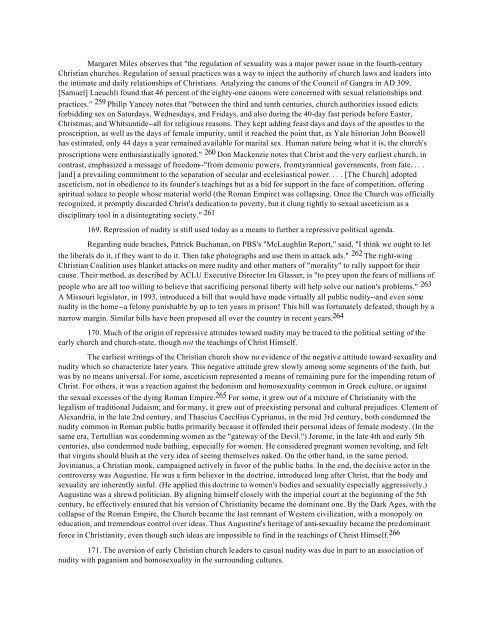You also want an ePaper? Increase the reach of your titles
YUMPU automatically turns print PDFs into web optimized ePapers that Google loves.
Margaret Miles observes that "the regulation of sexuality was a major power issue in the fourth-century<br />
Christian churches. Regulation of sexual practices was a way to inject the authority of church laws and leaders into<br />
the intimate and daily relationships of Christians. Analyzing the canons of the Council of Gangra in AD 309,<br />
[Samuel] Laeuchli found that 46 percent of the eighty-one canons were concerned with sexual relationships and<br />
practices." 259 Philip Yancey notes that "between the third and tenth centuries, church authorities issued edicts<br />
forbidding sex on Saturdays, Wednesdays, and Fridays, and also during the 40-day fast periods before Easter,<br />
Christmas, and Whitsuntide--all for religious reasons. They kept adding feast days and days of the apostles to the<br />
proscription, as well as the days of female impurity, until it reached the point that, as Yale historian John Boswell<br />
has estimated, only 44 days a year remained available for marital sex. Human nature being what it is, the church's<br />
proscriptions were enthusiastically ignored." 260 Don Mackenzie notes that Christ and the very earliest church, in<br />
contrast, emphasized a message of freedom--"from demonic powers, from tyrannical governments, from fate. . . .<br />
[and] a prevailing commitment to the separation of secular and ecclesiastical power. . . . [The Church] adopted<br />
asceticism, not in obedience to its founder's teachings but as a bid for support in the face of competition, offering<br />
spiritual solace to people whose material world (the Roman Empire) was collapsing. Once the Church was officially<br />
recognized, it promptly discarded Christ's dedication to poverty, but it clung tightly to sexual asceticism as a<br />
disciplinary tool in a disintegrating society." 261<br />
169. Repression of nudity is still used today as a means to further a repressive political agenda.<br />
Regarding nude beaches, Patrick Buchanan, on PBS's "McLaughlin Report," said, "I think we ought to let<br />
the liberals do it, if they want to do it. Then take photographs and use them in attack ads." 262 The right-wing<br />
Christian Coalition uses blanket attacks on mere nudity and other matters of "morality" to rally support for their<br />
cause. Their method, as described by ACLU Executive Director Ira Glasser, is "to prey upon the fears of millions of<br />
people who are all too willing to believe that sacrificing personal liberty will help solve our nation's problems." 263<br />
A Missouri legislator, in 1993, introduced a bill that would have made virtually all public nudity--and even some<br />
nudity in the home--a felony punishable by up to ten years in prison! This bill was fortunately defeated, though by a<br />
narrow margin. Similar bills have been proposed all over the country in recent years. 264<br />
170. Much of the origin of repressive attitudes toward nudity may be traced to the political setting of the<br />
early church and church-state, though not the teachings of Christ Himself.<br />
The earliest writings of the Christian church show no evidence of the negative attitude toward sexuality and<br />
nudity which so characterize later years. This negative attitude grew slowly among some segments of the faith, but<br />
was by no means universal. For some, asceticism represented a means of remaining pure for the impending return of<br />
Christ. For others, it was a reaction against the hedonism and homosexuality common in Greek culture, or against<br />
the sexual excesses of the dying Roman Empire. 265 For some, it grew out of a mixture of Christianity with the<br />
legalism of traditional Judaism; and for many, it grew out of preexisting personal and cultural prejudices. Clement of<br />
Alexandria, in the late 2nd century, and Thascius Caecilius Cyprianus, in the mid 3rd century, both condemned the<br />
nudity common in Roman public baths primarily because it offended their personal ideas of female modesty. (In the<br />
same era, Tertullian was condemning women as the "gateway of the Devil.") Jerome, in the late 4th and early 5th<br />
centuries, also condemned nude bathing, especially for women. He considered pregnant women revolting, and felt<br />
that virgins should blush at the very idea of seeing themselves naked. On the other hand, in the same period,<br />
Jovinianus, a Christian monk, campaigned actively in favor of the public baths. In the end, the decisive actor in the<br />
controversy was Augustine. He was a firm believer in the doctrine, introduced long after Christ, that the body and<br />
sexuality are inherently sinful. (He applied this doctrine to women's bodies and sexuality especially aggressively.)<br />
Augustine was a shrewd politician. By aligning himself closely with the imperial court at the beginning of the 5th<br />
century, he effectively ensured that his version of Christianity became the dominant one. By the Dark Ages, with the<br />
collapse of the Roman Empire, the Church became the last remnant of Western civilization, with a monopoly on<br />
education, and tremendous control over ideas. Thus Augustine's heritage of anti-sexuality became the predominant<br />
force in Christianity, even though such ideas are impossible to find in the teachings of Christ Himself. 266<br />
171. The aversion of early Christian church leaders to casual nudity was due in part to an association of<br />
nudity with paganism and homosexuality in the surrounding cultures.


